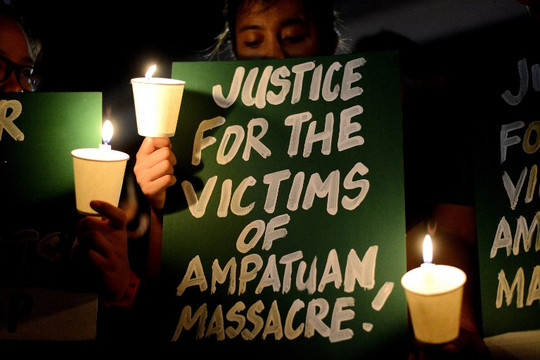“ Just because you’re a journalist you are not exempted from assassination, if you’re a son of a bitch”. Since his election in June 2016, President Duterte has continuously targeted media and journalists he disagrees with. One of the most prominent cases is the trumped-up charges against Rappler news website for its reporting on President Rodrigo Duterte’s so-called “drug war” and the spurious prosecution as well as online harassment against its CEO Maria Ressa.
In May 2019, the Duterte Administration accused several journalists and media organisations of an alleged plot to overthrow his government during the upcoming mid-term elections. They include the former chair of NUJP Inday Espina-Varona, Rappler CEO Maria Ressa and media outlets Rappler, Vera Files and the Philippines Center for Investigative Journalism.
Since late 2018, media organisations and journalists have been increasingly targeted for red-tagging, the practice of openly accusing persons or groups of membership of - or support for- the communist rebel movement.
All this when there is still no justice for the victims of Maguindanano massacre in 2009, the single bloodiest incident for journalists in the Philippines. While convictions in this case should undoubtedly be considered a major victory in the pursuit for justice for the victims, it remains unclear what impact, if any at all, these will have on the continuing struggle to defend and preserve freedom of the press and of expression in the Philippines.
The national Union of Journalists in the Philippines (NUJP) has recorded 186 killings of journalists since 1986, with alarming frequencies from 2004 to 2005.
The worst mass killing of journalists was the one that occurred 10 years ago, on November 23, 2009, where 58 people, including 32 journalists, were brutally murdered in Sitio Masalay, Ampatuan, in Mindanao in the southern Philippines. The group was travelling to Sharrif Aguak to file candidacy papers for the national elections. The convoy was stopped at a roadside checkpoint near Ampatuan town by over 100 armed men. The convoy was then diverted to a side road towards a hilltop outside Sitio Masalay, where over the course of an hour they were shot. The massacre is the deadliest attack on media workers in the country.
While the Ampatuan Massacre received global condemnation, not a single person out of the 198 suspects arrested has been convicted of this crime ten years on.
The NUJP says that among the 186 killings recorded since 1986, only 17 cases were resolved, namely the killings of Dionisio Perpetuo Joaquin, Nesino Paulin Toling, Alberto Berbon, Odilon Mallari, Rolando Ureta, Edgar Damalerio, Rowell Endrinal, Marlene Esperat, Klein Cantoneros, George Benaojan, Herson “Boy” Hinolan, Armando “Rachman” Pace, Arecio Padrigao, Miguel “Mike” Belen, Gerardo “Doc Gerry” Ortega
“As long as government fails or refuses to solve a substantial number of not only media murders but all other extrajudicial killings and human rights violations, the culture of impunity that has allowed murderers and masterminds to get away with their crimes will ensure not only continued bloodshed but also make a repeat of such a heinous crime as the Ampatuan massacre all too possible, if not inevitable,” said Nonoy Espina, chair of NUJP

